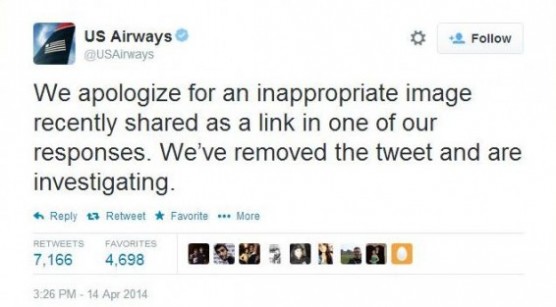
US Airways' Graphic Mistweet is a Lesson in Reputation Management

Earlier this year, an enormously inappropriate tweet landed on the official US Airways Twitter feed (pun most definitely intended) and the airline paid the price in spades. It took nearly an hour for US Airways to become aware of the tweet and remove it. By then, it had been retweeted over 500 times and was trending bigger on Twitter than the Pulitzer Prize nomination announcements that debuted the same day. It was a monumental mistake and has sparked countless points-of-view on the Internet since, from news outlets to marketing and business analysts. US Airways’ resulting PR disaster wasn’t 100% avoidable – social media gaffes never are. But there were ways to protect against it and plan for its contingency. US Airways had indicated it had guidelines in place, but apparently there was a breakdown in procedure. Policies and guidelines alone cannot minimize the possibility of mistakes on social media. Proper training, implementation, and social listening are also vital when (not if) mishaps take place to manage the situation and your brand’s reputation.
Flight Training
Social media experts aren’t the only people representing the brand online. Every employee, whether in official or unofficial capacities, represents and shapes the brand’s image in the social medium. A set of social media guidelines and policies that direct employee brand representation is absolutely critical to success. Some are long: the United States Army’s policies are over 80 pages. Others are short: Adidas, a multinational corporation, has a two-page policy. A social media policies document covers the commitments of the brand, it outlines the expected conduct of employees on behalf of the brand, and it provides simple, clear guidelines for personal and professional use of social media channels. Amongst them is the most important guideline to remember:
“When in doubt, don’t post.”
Most companies empower only certain people to speak officially for the company in order to minimize risk. Usually, these spokespeople receive training and education about the company and its mission and policies, the specific social media management tools, and any legal issues that might arise from communicating with the public. These trained professionals are the first line of defense for brand reputation and help to navigate tumultuous situations with a consistent brand voice and the necessary finesse social media requires. Training doesn’t stop there, though. Brands can ensure that everyone who posts on behalf of the brand understands how to use social media. Frustration with technology can often exacerbate mistakes, which sometimes proves costly. In US Airways’ case, it meant understanding how tweets get flagged and/or retweeted; according to a spokesperson from US Airways’ partner, American Airlines, the tweet was captured to flag it as inappropriate, but it was not processed correctly and instead ended up on US Airways’ own feed.
Checking Instruments
Training is great, but it’s not the end-all; proper implementation must be another factor for reputation management. In the US Airways’ case, their social media professional got up and walked away after reporting the offensive tweet without double-checking to make sure it was gone. It’s always a good idea to double-check that whatever action you’ve done was actually completed. Whether it’s checking that the post attached the image or ensuring that offensive content is removed, going over your work will minimize risk. In US Airways’ case, double-checking would have caught the error early; maybe ten people would have still seen something inappropriate, but it would have prevented the other 100,000 from seeing the same thing.
Air Traffic Control
For US Airways, it wasn’t the initial tweet that was the problem, so much as the response. The hundreds of retweets of the initial tweet magnified the initial ripple into a tidal wave of press. Social listening could have been critical to successfully managing the response. Social listening is the act of monitoring what is said about your brand online through a variety of tools. Most large brands use enterprise tools like Meltwater or Radian6 that run search queries around your brand’s name or vertical. But there are free tools, too. HootSuite has a listening dashboard, as does SproutSocial. Twitter and Facebook themselves can even push notifications to your mobile phone to notify you of interaction with your posts. The nature of these social channels allows almost instantaneous response, so these listening tools can help manage your brand’s reputation by alerting you when abnormal activity arises.
Final Approach
US Airways made a simple mistake on Twitter. Many brands have, many more will. But it doesn’t mean that you’re helpless to mitigate your brand’s risk. Proper and continually updated training and implementation procedures, along with a good social listening system, can help alert you to potential issues in social media before they become problematic. Social media is a lot like airline travel: no one pays attention to a smooth flight. But the second turbulence hits, people start to notice. A solid plan can help you get out of the rough air safely and quickly, and back on the path to smooth sailing.


